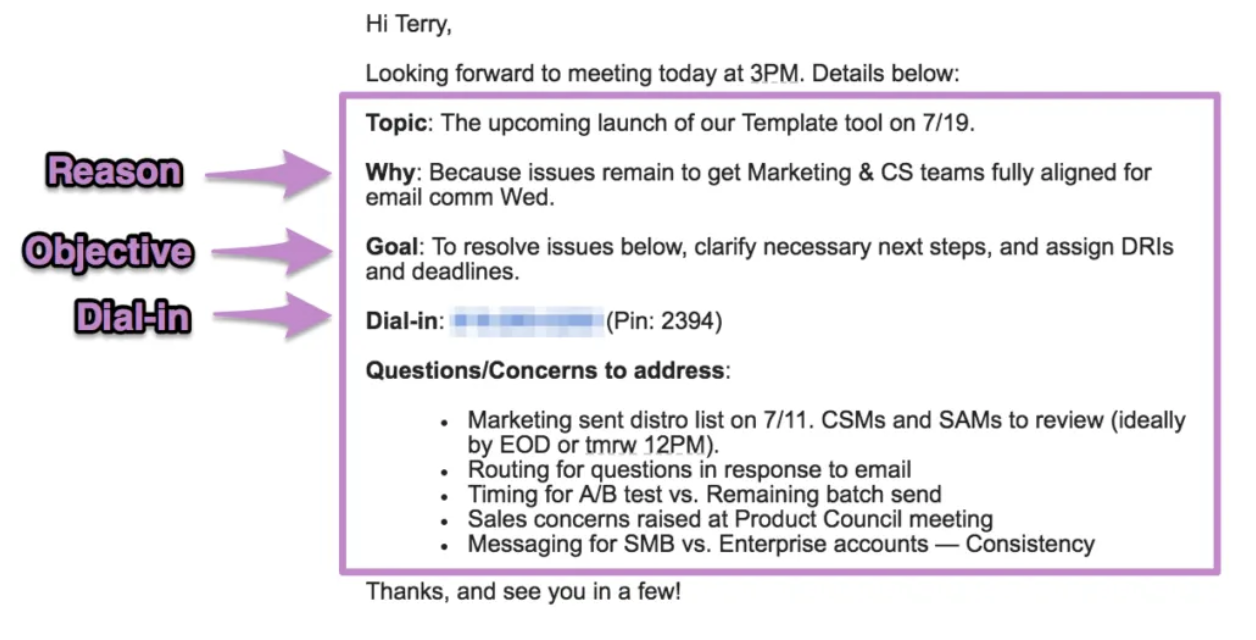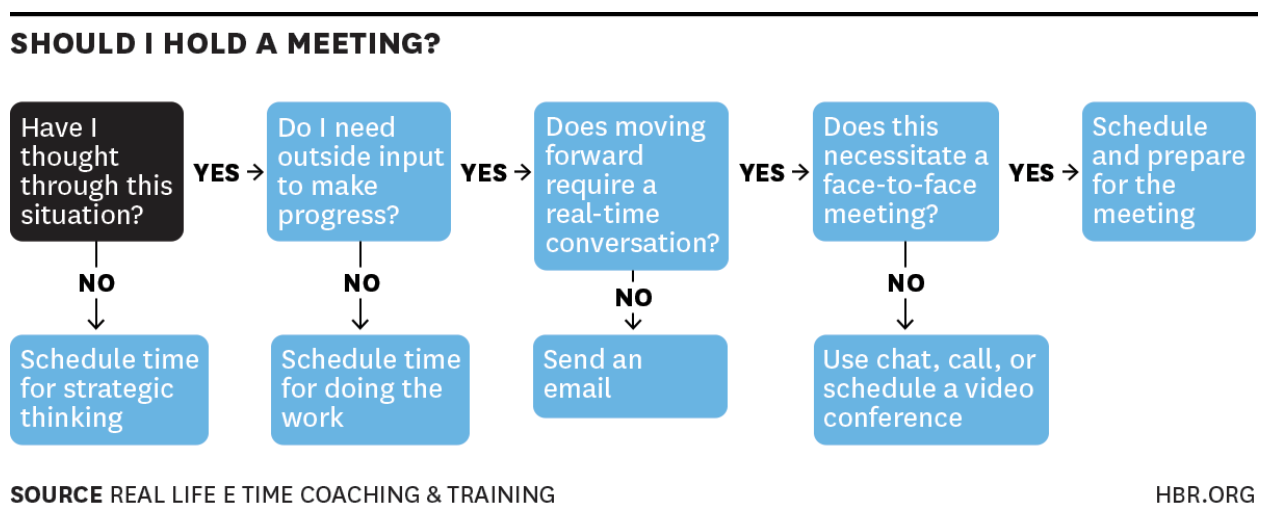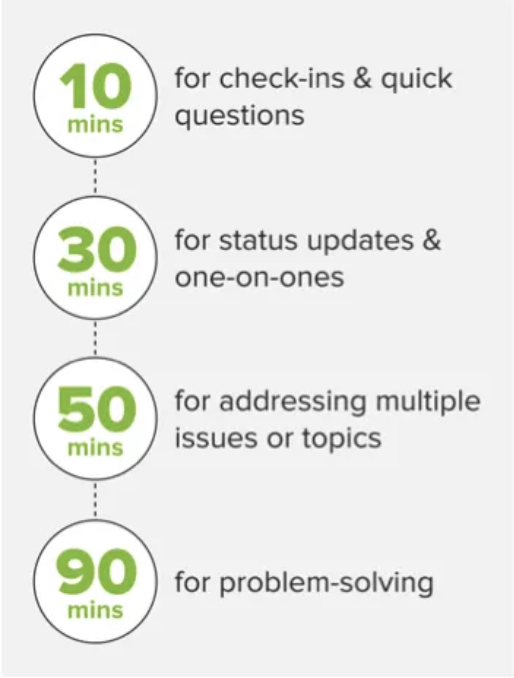Hold a Meeting with Confidence (With Our Best Meeting Agenda Templates)
Sophia Seltenreich
Without a meeting agenda, you risk scheduling yet another unproductive meeting.
According to a recent study by Atlassian, employees are attending roughly 62 meetings a month — half of which are considered a waste of time.
That’s 31 unnecessary meetings every month. When you get the sense that a meeting keeps getting pushed off by a once-interested prospect, stop and make sure you’ve been explicit about the goal of the call and what the meeting agenda includes. Setting an agenda shows the prospect that you’re not winging it and instills confidence that you won’t be wasting their time.
Read below for 5 tips on meeting setting and 2 meeting agenda templates you can use to plan meetings that are productive and respect everyone’s time.
All Meetings Are Not Equal – What to Do About It
Every day, people open their calendars to book a meeting, add participants, and find an available room. What most people fail to do is recognize the most important step and a key predictor of success — identifying whether the meeting is formal or informal.
It’s something that can’t be skipped because the answer dictates the agenda.
Here are five important distinctions between the two meeting types:
1. Buy-In: Have People Already Agreed to This Meeting?
Formal meetings have a handshake before the agenda is sent: everyone agrees to attend.
Informal ones don’t, your agenda isn’t just an agenda. It’s also the invite. This means you need to lay the groundwork by telling them “why” with context.
People skip meetings or tune out while they sit in them because they don’t see the value, so laying out the agenda beforehand will help them determine the meeting’s value to them.
2. Ground to Cover: How Big Is the Goal of This Meeting?
While informal meetings have a smaller, more easily achievable goal, formal meetings typically tackle a larger topic. This means more people weighing in, more layers to peel, and more questions asked.
To avoid getting sidetracked in larger, formal meetings, you should give everyone a “parking lot.” The Parking Lot is a productivity technique to deal with distracting (but important) non-agenda items.
Here’s how it works:
- Have a whiteboard or Google Doc to write items down on. This can also be built into your meeting agenda template.
- When a tangential issue comes up, write it down with the name of who brought it up.
- Depending on the time at the end of the meeting, either revisit Parking Lot items or address them in a recap email afterward.
3. Audience: Who and How Many People Will Be Attending?
Informal meetings typically involve a small number of coworkers, which means you all know each other. Formal meetings don’t. They’re for larger internal meetings and external meetings with customers, prospects, or vendors.
What to do: Layout each attendee’s name, title, and company name (if external). You should also block out agenda items each person owns and allotted time for each topic.
4. Where the Agenda Lives: In Email or Outside of It
Informal meeting agendas live in two places: the initial invite and the reminder email.
Because formal emails are longer, they can be printed and provided by hand in a meeting or sent via Google doc or another file type as an attachment in advance.
5. Requirements: Do Attendees Need to Take Steps Beforehand?
The answer here is most often “no” for informal meetings. Attendees just bring themselves. But for formal meetings, the answer is “yes.”
Attendees are usually asked to submit something, come with written ideas, answer hanging questions by email or in a live doc beforehand.
Here’s why:
Research shows that writing down ideas before a meeting can actually generate 20% more ideas and 42% more original ideas than during the meeting.
The Only Meeting Agenda Templates You Need to Get Started
1. Informal Meeting Agenda Template
Your meeting agenda should absolutely include:
- Reason why meeting is necessary
- Objective: Where do you plan to get to by the end of the meeting?
- Dial-in information/location.
Here’s what it looks like in action:

Steal the full template below (to save for re-use, you can copy and paste it into this tool):
Topic: {!What will be discussed}
Why: {!Because ___}.
Goal: {!To ___}.
Dial-in: {!Delete if unnecessary}.
Questions/Concerns to Address:
{!Item 1}
{!Item 2}
{!Item 3}
Here’s a doc with the template – for easy copying.
2. A Formal Agenda Template for Your Next Big Meeting
If you’re leading a formal meeting, this is the template for you.
To edit the Google doc, you have two options. If you want to work in it as a Google doc, choose File > Make a Copy. To edit it as a Word doc, select File > Download As > Microsoft Word.
Meeting Agenda Etiquette: Make the Most Out of Your Time
Do’s
- Double-check for typos: Typos make you appear less competent and give the idea that you aren’t even trying to impress your attendees. You can avoid them by downloading a simple plug-in like Grammarly to check your writing for errors.
- Put the important topics first: Two words: cognitive backlog. The more information you throw at your audience, the more likely they are to drop everything. It’s why so many TED Talks run around 18 minutes, it’s a time sweet spot before our brains get restless and look elsewhere for stimulation.
- Ask yourself: is this meeting necessary? Use this infographic from Harvard Business Review to help determine whether or not a meeting is fully necessary (and if isn’t, save everyone’s time by canceling).

Don’ts
- Don’t forget to nudge recipients with an email reminder: This is a good catchall for both people who missed your meeting on their calendar and those who have forgotten to do the prep you’ve asked for. Schedule a Send Later email to drop in their inboxes an hour before the meeting.
- Don’t under or overbook meeting time: Once you determine all of your agenda items, you can use the 10-30-50-90 Rule to determine how long you’ll need:

- Don’t run over your allotted meeting time: During meetings at Google, a giant clock is projected to show how much time is remaining in the meeting. It’s impossible to ignore and creates social pressure to stay on track. A simple way to do this? Set a timer for 3 minutes before your meeting is scheduled to end. This provides enough time to tie up loose ends and decide whether a follow-up meeting is necessary.
Get sales tips and strategies delivered straight to your inbox.
Yesware will help you generate more sales right from your inbox. Try our Outlook add-on or Gmail Chrome extension for free, forever!
Related Articles
Ginelle DeAntonis
Casey O'Connor
Casey O'Connor
Sales, deal management, and communication tips for your inbox

